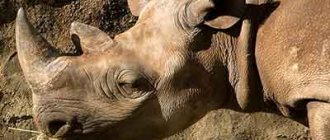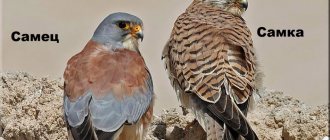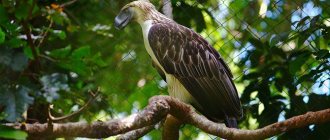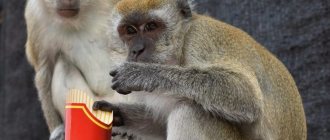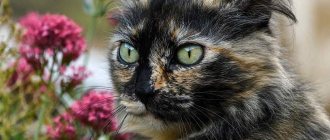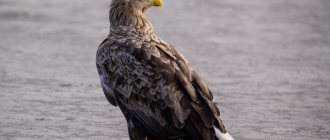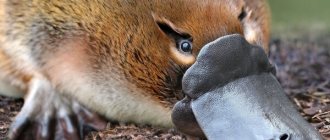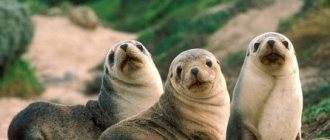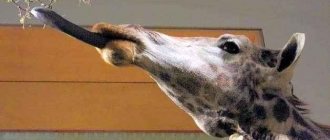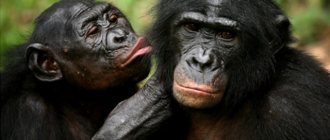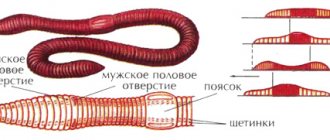Carnivora (Carnivora - “carnivorous”) is a order of mammals that includes more than 270 species. More generally, a carnivore is any animal (or plant, see carnivorous plants) that eats other animals, as opposed to herbivores, which eat plants. Although the species classified in this order are primarily carnivores, a significant number of them, especially bears and raccoons, also actively feed on vegetation and are thus effectively omnivores.
Bearish
Most of the brown bear population lives in Russia, Alaska and Canada, and, for example, in Ukraine they are preserved only in the Carpathians.
Brown bear
The polar bear is the largest land predator. Its weight reaches 800 kg. More adapted to predation than the brown one. It feeds mainly on seals and young walruses. Carries out seasonal migrations. During the breeding season, females concentrate in certain places, “maternity hospitals,” where up to 100 or more bears gather.
Female polar bear with cub
Dimensions
The smallest living representative of the order Carnivora is the common weasel (Mustela nivalis), which weighs up to 250 grams. The largest land mammal of prey is the Kodiak bear (Ursus arctos middendorffi), an Alaskan subspecies of brown bear that is even larger than the polar bear (Ursus maritimus). The largest aquatic predatory mammal of the pinniped group is the southern elephant seal (Mirounga leonina), which can weigh about 3,700 kg. Most carnivorous animals have a body weight of 4 to 8 kg.
Hyenas
Hyenas are both active predators and scavengers who completely utilize animal carcasses. Striped hyenas live in Asia, and their spotted relatives live in Africa. The latter settle in large clans of up to 100 or more individuals. Many people consider hyenas to be related to wolves and dogs, but they belong to the order Felidae.
spotted hyena
Mammals from the order Carnivora - what suborders belong to them?
Order of carnivorous mammals
It is interesting that not all animals that eat other animals fall into the order of carnivores. There are no primates, for example, a hedgehog (he is in the order of insectivores) or a hippopotamus (he is an artiodactyl).
There are also no crocodiles in the order of predatory mammals. Because he is not a mammal at all, he is a reptile. Different reptiles have different gastronomic preferences. They are mostly insectivores, but there are turtles with vegetarian preferences, and true carnivores, crocodiles and some lizards.
- A carnivorous mammal has a shorter intestine than a herbivore. A predator's intestines are 3-5 times longer than its body. And in a herbivore, the length of the intestine is usually 15-20 times longer than the body. This is due to the fact that meat is digested faster than plant foods. Interestingly, the human intestine is 12 meters long, and it is somewhere in the middle.
- Animals from the order Carnivorous Mammals have weapons in the form of fangs and claws for hunting and eating food.
- In a predatory mammal, sweat glands are located only in certain areas. For example, on a dog’s tongue, and on a cat’s paw pads. Whereas herbivores have many sweat glands throughout the surface of the body. They need to graze and stay in the sun for a long time.
The order of Carnivores includes about 280 species of modern animals. Carnivores are usually divided into two large groups : cat-like and canine . Although these names do not entirely correspond to which animals fall into these groups. For example, walruses are classified as caniforms, and hyenas, which, in our opinion, are more like dogs, are classified as feliforms. Now let's try to understand in more detail which animals of the carnivorous order belong to which suborder.
Canids
Of the canine family, the wolf is the most specialized species. He is the only ancestor of domestic dogs. A very agile, hardy, intelligent and careful animal. Avoids a person, but is not afraid. In Russia and Ukraine, wolves are found in all natural areas except Crimea. In most European countries the wolf has been exterminated.
Wolves
A close relative of the wolf, the jackal, is found in northern Africa, Central Asia and the Caucasus. In recent years, cases of jackals entering the territory of Ukraine have been recorded.
Jackal, Namibia, Etosha National Park
The maned wolf (guara) resembles a fox on long slender legs, which make it easy to move among the tall grass of the pampas and through swamps. Its homeland is South America. Having gathered in flocks, they attack sheep.
Maned wolf
The raccoon dog is a rather conventional predator. It feeds on amphibians, small rodents, mollusks, bird eggs, etc. It acclimatized on the territory of the European part of the former USSR in the 1940s, then penetrating into many countries of Western Europe. This is the only representative of the canids that hibernates in winter.
Raccoon dog
The common or red fox, so well known to us from childhood, lives over a vast territory of Europe and Asia, as well as in North Africa. Omnivore, but the main diet consists of mouse-like rodents.
Red fox
The fennec fox is a unique miniature fox with extremely large ears that pick up quiet sounds. A resident of the sands of North Africa and Arabia, in case of danger he instantly buries himself in the sand.
Fennec (player below - voice sound)
The arctic fox, or polar fox, inhabits exclusively the Arctic and Subarctic regions. In winter, these animals turn snowy white. In years when there is no harvest for lemmings, Arctic foxes migrate en masse. During migrations they are able to cover distances of up to 5000 km.
Arctic fox
Are humans predators or herbivores?
Biological classification gives a clear answer to the question of whether a person is a predator or a herbivore. No, humans do not belong to the group of predators. And humans are not very similar in body structure to predatory mammals. On the other hand, the division of biological species into predators and herbivores is very arbitrary. Animals simply eat whatever suits and pleases them. Primates can eat both fruits and insects. And wild wolves from the southern regions sometimes indulge in watermelons. She-wolves bring chewed rhubarb roots to their cubs. Roughly the same thing happens with a person’s gastronomic preferences.
Musteluns
Mustelids form a large and diverse family. They lead a terrestrial, arboreal and semi-aquatic lifestyle. Among the mustelids found in the fauna of Russia are: martens, weasel, ermine, steppe and forest ferret, bandage, badger, otter, European mink and wolverine. Most of these species are rare and endangered.
Variety of mustelids
The otter settles along the banks of clean rivers and reservoirs rich in fish and crayfish. It makes shelters in the form of burrows on the banks and in coastal thickets. The fur of many mustelids, especially sable and mink, is highly valued. The durability of otter fur in the fur industry is taken as 100%.
Otter
Kharza is the largest marten with a very bright color. Inhabits tropical mountain forests of Southeast Asia, deciduous forests of China, Manchuria and Primorye. It moves quickly through trees and attacks small ungulates.
Kharza (yellow-breasted marten) in the wild, Kaeng Krachan National Park, Thailand
The striped skunk lives in America. In case of danger, it sprays the secretion of the tail gland into the enemy, which has a very unpleasant odor.
striped skunk
The badger and honey badger are not very similar in appearance to martens, but are still their closest relatives.
Female honeyeater (Mellivora capensis) with young pup in Kgalagadi Transfrontier Park, Northern Cape, South Africa
The sea otter, or sea otter, is the only representative of the family that lives in the seas. Its fur is very highly prized.
Sea otter
Description
The vast majority of species are terrestrial, but pinnipeds are well adapted to life in the water. Some non-pinnipeds, such as sea otters, are almost entirely aquatic, while others, such as river otters and polar bears, are semi-aquatic, spending most of their lives in or near water. Aquatic and semi-aquatic animals have evolved special adaptations, including streamlined bodies and webbed limbs.
Carnivores, like other mammals, have a number of different types of teeth: incisors at the front, then canines, premolars, and molars at the back. Most carnivores have carnassial teeth, which function to cut meat and tough tendons. The carnassial teeth are usually formed by the fourth upper premolar and the first lower molar. Cats, hyenas and weasels are extremely carnivorous, having well-developed carnassial teeth. Bears and raccoons (except the bushy-tailed olingo) are generally omnivores, and seals that eat fish or marine invertebrates have virtually no carnassial teeth. Teeth located behind the carnassial teeth tend to be lost or reduced in size in exclusively carnivorous species.
Several skeletal features are characteristic of the order Carnivora. The condyles on the lower jaw form a semi-cylindrical hinge that allows the jaw to move only in a vertical plane and with considerable strength. The collarbones are either significantly reduced or absent, and, if present, are usually embedded in the muscles without connection to other bones. This provides greater flexibility in the shoulder area and prevents collarbones from breaking when the animal hunts its prey.
The brain is large in relation to body weight, and contains the complex convolutions characteristic of highly intelligent animals. The stomach is simple and the cecum attached to the intestine is usually reduced or absent. Because animal tissue is generally easier to digest than plant tissue, carnivores' reliance on a diet with significant amounts of meat resulted in a less complex stomach structure and a reduction in stomach length and intestinal surface area. The nipples are located on the abdominal cavity along two primitive lines (mammary lines), characteristic of mammals, necessary for feeding the young with mother's milk.
Felines
The cat family is a highly specialized and fairly uniform group of carnivores. They live on all continents except Australia. They lead a solitary, sometimes group, lifestyle.
Representatives of felines
The wild forest cat inhabits the forests of Central and Southern Europe and the Caucasus. It is found in Ukraine in the Carpathians, as well as in the Danube and Dniester deltas. It feeds mainly on small rodents. Although the forest cat is similar to domestic cats, it is not their ancestor. Domestic cats are descended from the steppe cat, which is native to Africa and Asia and was domesticated in ancient Egypt.
Central European forest cat
The sand cat and Pallas cat are native to Africa and Asia and feed on small rodents, lizards and birds. The jungle cat, or house, is a strong and aggressive animal, well adapted to life among reed thickets and thorny bushes. Pallas's cat prefers rocky uplands and treeless slopes, where it settles in marmot burrows and rock crevices. Common in the Caucasus and Transcaucasia.
Manul
The lynx is a fairly large cat with a short tail. It lives in most of Russia, in Ukraine - in the Carpathians, where its numbers depend on the number of roe deer, and sporadically in the forests of northern Ukraine. Listed in the Red Book of Ukraine.
Lynx
The caracal is similar in appearance to a lynx, but its red-sandy coloration indicates that it is an inhabitant of deserts and semi-deserts.
Caracal
The puma is rightly called the “American lion.” It lives in North and South America. Its diet consists of animals from rodents to monkeys and small deer, and occasionally attacks livestock.
Puma
The lion, which previously inhabited almost the entire African continent, the Arabian Peninsula and the southern part of Eurasia from Greece to India, is now virtually preserved only in Central Africa.
a lion
The tiger is a resident of the Asian continent. The largest of the cats is the Ussuri tiger. It lives in Primorye and the Far East.
Tiger
The leopard, or leopard, inhabits most of Africa and southern Asia, settling in the savannah, tropical and subtropical forests.
Leopard
In North and South America there lives a jaguar similar to a leopard. This big cat prefers tropical forests and willingly swims across wide rivers. Hunts ungulates, alligators, turtles and fish.
Melanistic Jaguar (Black Panther)
The snow leopard, or snow leopard, lives in the mountains of Central Asia, Mongolia, the Himalayas and Tibet.
Snow Leopard
The cheetah looks more like a dog than a cat. In addition, like a dog, it has claws that do not retract into the paw pads. This is the fastest mammal, it can reach speeds of up to 110 km/h. In India and Iran, domesticated cheetahs were widely used to hunt antelope. Hunting cheetahs were already known during the times of Kievan Rus.
Cheetah
Second place - bull shark
Bull shark or bull shark
Among the inhabitants of the water element, the most bloodthirsty predator is the bull shark. It is no coincidence that this name was given to a dangerous fish: when it swims into fresh waters, it approaches the shore and hunts bulls who have come to drink. Due to its large head and flattened snout, this shark is also called the blunt-nosed shark. An unpleasant encounter with a sharp-toothed killer can occur in all the world's oceans (with the exception of the Arctic Ocean). In the United States of America, cases of bull sharks have been recorded in Lake Michigan and rivers in New Jersey and Illinois.
Protecting its possessions, the huge fish attacks any moving object, mistaking even boat propellers for trespassers. Ichthyologists explain the incredible aggressiveness of blunt-nosed sharks by the production of large amounts of the hormone testosterone.
The sea monster's victim has no chance of survival. In pursuit of prey, 3.5-meter giants weighing 300–350 kg accelerate to 40 km/h. The scenario is always the same: the hunter delivers a powerful blow with his head and finishes the job with jagged teeth growing in several rows. Swimming into shallow waters, bull sharks cause death to unwary swimmers. According to statistics, 26 people died from the teeth of the ocean aggressor.
Interesting: The smallest dog breeds in the world - list, names, size, photos and videos
Reproduction
Many carnivores have a well-developed baculum. Its structure appears to play a role in successful copulation and fertilization of females. Felids have a vestigial baculum or no baculum at all, but the walrus baculum can reach a length of about 54 cm.
Mating systems vary between families, ranging from monogamy in wolves and polygyny in most bears, and ground squirrels to harems in elephant seals. Copulation is vigorous and frequent in many species, including lions, and many species have reproductive features as adaptations to their environment. For example, induced ovulation allows females to release eggs during or shortly after mating. Delayed implantation of a fertilized egg in the uterine wall is another adaptation that allows babies to be born when needed resources are abundant. This phenomenon is most noticeable in species living in seasonal conditions. Delayed implantation is most extreme in pinnipeds and bears, but is absent in wolfs.
9. Steller sea lions, fur seals and sea lions (eared seal family (Otariidae))
The family includes fur seals, sea lions and sea lions, which can be distinguished from representatives of true seals (see previous paragraph) by their small external ears. Eared seals are more suited to life on land than their earless seal relatives, using their powerful front flippers to propel themselves across land or ice. Oddly enough, they tend to move faster and more maneuverably in the water than true seals.
Eared seals also have the most sexual dimorphism of any mammal in the animal kingdom: male fur seals and lions can weigh up to 6 times more than females.
Wolves
These are, of course, predatory animals, photos of which should not be shown to anyone. Most of the most dangerous individuals prefer to live alone, relying solely on their own strength. However, most live in packs. This makes it easier to get food. Success in hunting usually depends on all members of the pack. The hunt begins with the pursuit of prey, which flees from angry predators. The dominant male leads the hunt. As soon as the victim accidentally trips and falls, the pack immediately surrounds him and kills him.
How to recognize the Amur leopard
The weight of male Far Eastern leopards varies between 32-48 kilograms; previously, larger representatives of the species weighing up to 60-75 kilograms were also found. Females weigh much less than males, their weight reaches 25-43 kilograms.
The average body length of Amur leopards is 105-135 centimeters. At the withers they reach 65-75 centimeters. Far Eastern leopards have a long tail measuring about 80-90 centimeters.
The predator has thick, soft and long fur. In summer, the length of the fur is 2.5 centimeters, and in winter the fur becomes much longer - 7.5 centimeters. The fur on the back is shorter than on the belly.
768w,
1024w" style="box-sizing: border-box; max-width: 100%; height: auto; margin-bottom: 0px; width: 696px; display: block;" title=”The Amur leopard is a real predator.” width=”1200″ /> The Amur leopard is a real predator.
The main color of the skin is pale yellow, but the chest, belly and tips of the paws are lighter than the rest of the body. The skin is decorated with black spots. On the back and sides, the spots are closely adjacent to each other, and between them there are spaces of a yellowish-red color.
The coloring of Amur leopards is much lighter than that of African and Indian leopards. A distinctive feature of Far Eastern leopards is their blue-green eyes.
Behavior
Carnivorous creatures show the highest levels of intelligence among mammals. A large brain in relation to body size is an indication of their high mental abilities. For this reason, carnivores are among the most capable of learning for recreational purposes, as pets or hunting companions. The highly developed sense of smell among dogs, for example, complements the sharper vision found in humans. Dogs are carnivores that are trained specifically for hunting, but cheetahs, caracals and ferrets are also used to some extent for this purpose. In China, otters are trained to chase fish under large nets. Depending on their survival and ability to hunt animals in a wide variety of situations, carnivorous species have evolved a relatively high capacity for learning.
Carnivorous animals tend to create territories, although omnivorous carnivores such as baribal, striped skunk and raccoon are less prone to this behavior. Territories are often limited and protected from other members of their genus. Such areas may sometimes be marked with urine, feces, or special glands.
There is a wide range of social patterns among carnivores. Many (bears, foxes, genets, most cats and most mustelids) are solitary except during the breeding season. Some of them remain in pairs throughout the year (black-backed jackal and red panda) or sometimes wander in pairs (gray fox, maikong and kinkajou). Other carnivores, such as wolves, wild dogs, red wolves and roaches, usually hunt in packs or groups. Various pinnipeds form sessile colonies during the breeding season, sea otters congregate together for most of the year, and meerkats form permanent colonies.
Mongooses and meerkats (mongoose family (Herpestidae))
In many respects indistinguishable from stoats, badgers and otters of the mustelid family (see point 6), mongooses are widely known for their unique evolutionary “weapon”: these small mammals are almost completely immune to snake venom. You might infer that mongooses kill and eat snakes, but in reality this is purely a defensive adaptation, keeping pesky snakes at bay while the mongooses stick to their preferred diet of birds, insects and rodents.
The mongoose family also includes well-known animals - meerkats.
Miracles of selection
Since the lion and tiger are the most striking representatives of the entire animal world of the planet, genetic scientists have tried to create their hybrids. This experiment ended quite successfully, since the crossing resulted in viable individuals with new properties compared to the original forms. Thus, a liger is a hybrid of a lion and a tigress, capable of unlimited growth. In nature, this trait is characteristic of plants and fungi. The liger grows throughout its life, sometimes reaching a length of up to 3 meters.
Typically, interspecific hybrids are not capable of producing fertile offspring. Tiger Lion is an exception to this rule. This is practically the only case in selection. Females obtained by crossing a tiger and a lioness are capable of procreation.
